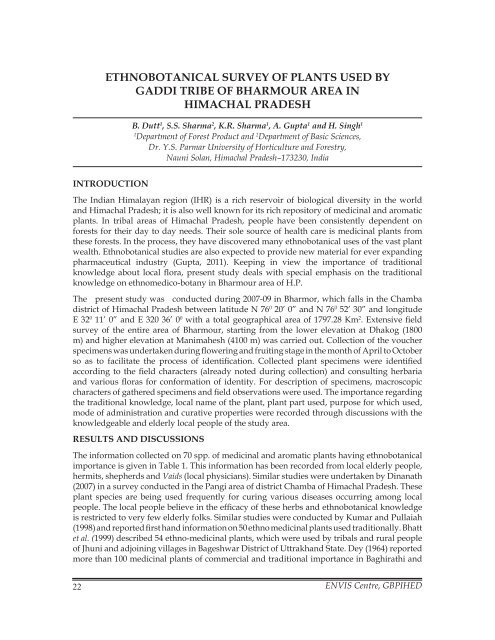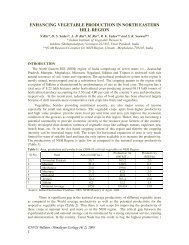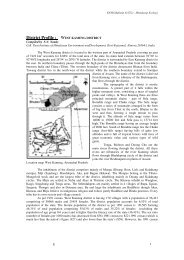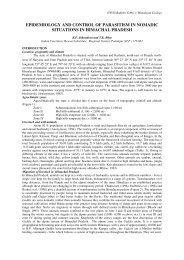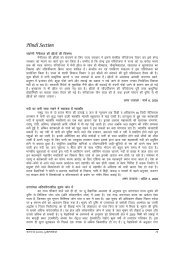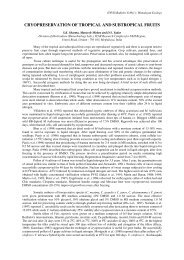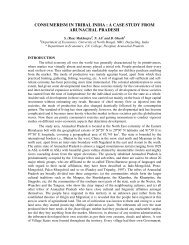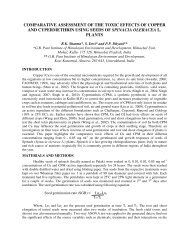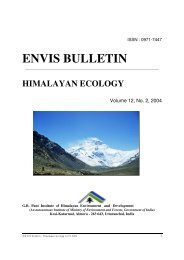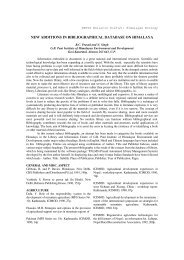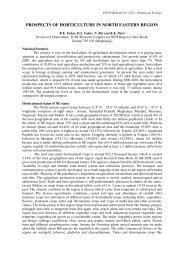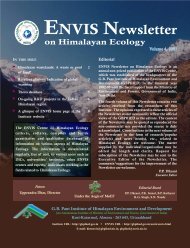Complete Bulletin (PDF) - ENVIS Centre on Himalayan Ecology
Complete Bulletin (PDF) - ENVIS Centre on Himalayan Ecology
Complete Bulletin (PDF) - ENVIS Centre on Himalayan Ecology
You also want an ePaper? Increase the reach of your titles
YUMPU automatically turns print PDFs into web optimized ePapers that Google loves.
ETHNOBOTANICAL SURVEY OF PLANTS USED BYGADDI TRIBE OF BHARMOUR AREA INHIMACHAL PRADESHB. Dutt 1 , S.S. Sharma 2 , K.R. Sharma 1 , A. Gupta 1 and H. Singh 11Department of Forest Product and 2 Department of Basic Sciences,Dr. Y.S. Parmar University of Horticulture and Forestry,Nauni Solan, Himachal Pradesh–173230, IndiaINTRODUCTIONThe Indian <strong>Himalayan</strong> regi<strong>on</strong> (IHR) is a rich reservoir of biological diversity in the worldand Himachal Pradesh; it is also well known for its rich repository of medicinal and aromaticplants. In tribal areas of Himachal Pradesh, people have been c<strong>on</strong>sistently dependent <strong>on</strong>forests for their day to day needs. Their sole source of health care is medicinal plants fromthese forests. In the process, they have discovered many ethnobotanical uses of the vast plantwealth. Ethnobotanical studies are also expected to provide new material for ever expandingpharmaceutical industry (Gupta, 2011). Keeping in view the importance of traditi<strong>on</strong>alknowledge about local flora, present study deals with special emphasis <strong>on</strong> the traditi<strong>on</strong>alknowledge <strong>on</strong> ethnomedico-botany in Bharmour area of H.P.The present study was c<strong>on</strong>ducted during 2007-09 in Bharmor, which falls in the Chambadistrict of Himachal Pradesh between latitude N 76 0 20’ 0” and N 76 0 52’ 30” and l<strong>on</strong>gitudeE 32 0 11’ 0” and E 320 36’ 0 0 with a total geographical area of 1797.28 Km 2 . Extensive fieldsurvey of the entire area of Bharmour, starting from the lower elevati<strong>on</strong> at Dhakog (1800m) and higher elevati<strong>on</strong> at Manimahesh (4100 m) was carried out. Collecti<strong>on</strong> of the voucherspecimens was undertaken during flowering and fruiting stage in the m<strong>on</strong>th of April to Octoberso as to facilitate the process of identificati<strong>on</strong>. Collected plant specimens were identifiedaccording to the field characters (already noted during collecti<strong>on</strong>) and c<strong>on</strong>sulting herbariaand various floras for c<strong>on</strong>formati<strong>on</strong> of identity. For descripti<strong>on</strong> of specimens, macroscopiccharacters of gathered specimens and field observati<strong>on</strong>s were used. The importance regardingthe traditi<strong>on</strong>al knowledge, local name of the plant, plant part used, purpose for which used,mode of administrati<strong>on</strong> and curative properties were recorded through discussi<strong>on</strong>s with theknowledgeable and elderly local people of the study area.RESULTS AND DISCUSSIONSThe informati<strong>on</strong> collected <strong>on</strong> 70 spp. of medicinal and aromatic plants having ethnobotanicalimportance is given in Table 1. This informati<strong>on</strong> has been recorded from local elderly people,hermits, shepherds and Vaids (local physicians). Similar studies were undertaken by Dinanath(2007) in a survey c<strong>on</strong>ducted in the Pangi area of district Chamba of Himachal Pradesh. Theseplant species are being used frequently for curing various diseases occurring am<strong>on</strong>g localpeople. The local people believe in the efficacy of these herbs and ethnobotanical knowledgeis restricted to very few elderly folks. Similar studies were c<strong>on</strong>ducted by Kumar and Pullaiah(1998) and reported first hand informati<strong>on</strong> <strong>on</strong> 50 ethno medicinal plants used traditi<strong>on</strong>ally. Bhattet al. (1999) described 54 ethno-medicinal plants, which were used by tribals and rural peopleof Jhuni and adjoining villages in Bageshwar District of Uttrakhand State. Dey (1964) reportedmore than 100 medicinal plants of commercial and traditi<strong>on</strong>al importance in Baghirathi and22<str<strong>on</strong>g>ENVIS</str<strong>on</strong>g> <str<strong>on</strong>g>Centre</str<strong>on</strong>g>, GBPIHED


